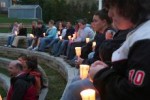Alumni profile
In the fall of 1951, this alumnus entered the hallowed halls of a revered tertiary educational institution, Castleton Teachers College, a fixture on the mid-western Vermont landscape since 1787. In the intervening years since its founding, it had undergone several metamorphoses to become the main supplier of teachers to the rural areas of southern Vermont.It was with some trepidation that this earnest scholar sat in on those early classes. Among the most memorable that first year were those of Professor Molly Markham, who taught music fundamentals. It was there that I learned the essentials of program music, i.e., that melodic sounds can tell a story, e.g., Till Eulenspiegel (The Merry Pranks of).
Later I studied a course in symphonic music with Miss Markham. What beauty! What power! What ecstasy! To this day I credit that Grand Dame with helping me to appreciate serious music. If only I had had the intestinal fortitude to pursue the study of opera, but in those days symphony was for males and opera was for females. How afraid men were then of being labeled “sissies”. Thank goodness society has moved beyond such silliness.
It was truly amusing to see Professor Jackson, the art teacher, drive up the campus road in her big convertible with the top down (even in chilly weather) with her Dalmatian, Donna, sitting upright in the passenger seat sporting a big colorful neck ribbon and bow. Donna was a regular in all Miss Jackson’s classes. Students learned to work in various media including chalk and wax crayons and colored pencils. She tried to free her students from the constraints of working in stereotypical ways and in so doing view the world with new eyes, so to speak. Her favorite expression was “Let your chalk (or crayon or pencil) do funny little things.” Her classes were such fun!
In the second year, students sat in on a seemingly radical type of class, one in which each student had a different biology book. Professor Keach, a tall, slender man with steel grey hair, conducted this novel approach to teaching. Previously students in a particular course had all learned information from the same source, but in his class students had to compare and contrast ideas from multiple sources. Students soon learned that authorities do not necessarily agree on all so-called facts. Also, under Mr. Keach’s direction, each student had to collect, identify, press, and label wild flowers indigenous to the region. The dried flowers covered by cellophane were then entered into booklets that had been especially printed for the activity. This writer collected some 150 wild flowers (not the garden variety) and has carefully preserved them to this day. Old Keach, as he was endearingly called by his students (but definitely not in his presence!), would entertain questions from the class.
One day a brave male student asked if one could contract a venereal disease from a toilet. Keach replied dryly, “That’s a helluva place to take a woman.”
Castleton, though not a multiversity, was intellectually challenging. All classes were small – not more than 25 in number — and they were usually conducted on the seminar plan, that is, students were given reading, research, and writing assignments and they had to be prepared to discuss issues under the guidance of a questioning and knowledgeable instructor.
No sitting in class daydreaming or listening to a teacher drone on in the background. A student did not dare to neglect an assignment for fear of being called upon to share his findings; being unprepared would have most certainly led to embarrassment.
Small classes were mentioned. Well, how would the reader like to be one in a class of two? This occurred twice in my academic life while studying for the baccalaureate at Castleton, once in geology and the other in calculus, both times with the same student, Tom Fitzpatrick. He was not only a rival, but a treasured friend and chess partner. He has been sadly missed these many years.
Not all life at Castleton was cerebral. I learned to play pinochle and contract bridge. It was at lunch in the cafeteria that this gourmand first tasted garlic. The whole cloves were in the simple oil and vinegar dressing, but what a difference the garlic made. These I deliberately spooned out of the dressing dish to put on greens greens, chewing them with great relish and savoring their marvelous flavor, but subsequently wondering why people hesitated to sit close to me in seminar!
I could write a book about my experiences at Castleton. Not only did studies prepare us for a vocation, but the total experience prepared us for life. This writer hopes the current generation of students will look back fondly on their undergraduate years at wonderful venerable Castleton some 50 years hence, too.
Maurice A. Brewster, Jr. Class of 1955






